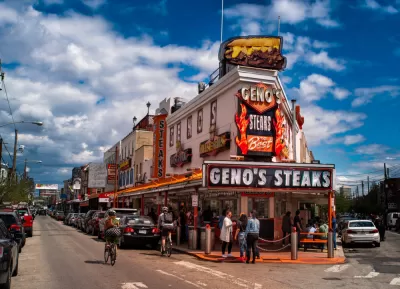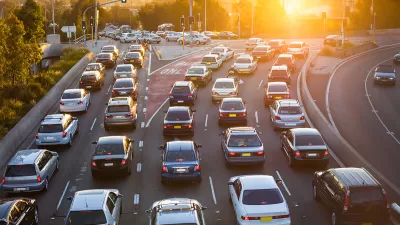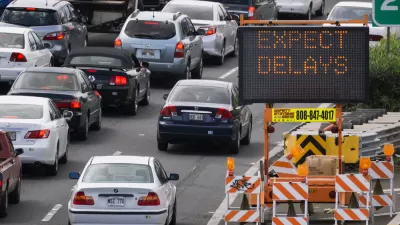A new study considers urban form, roadway characteristics, traffic collisions, and fatalities in the Philadelphia region, to show that the densest parts of regions are the safest places to drive and walk.

"New research from the University of Pennsylvania [pdf] shows that denser cities and towns can save lives," reports Ryan Briggs.
"The four-year long study compared Pennsylvania Department of Transportation records of all car accidents in a five-county region with population data, socioeconomic factors, different road types, and other factors," explains Briggs. "The resulting analysis, which examined collision data from 2010 and 2014, showed that the densest parts of the region –– like downtown Philly or suburban town centers –– had lower accident rates than more sprawling areas."
One key distinction in the data emerges when comparing pedestrian and vehicle safety. "While denser sections of the suburbs had lower accident rates overall, drivers fared better than pedestrians. Densely populated areas in the suburbs and some outlying Philadelphia neighborhoods actually experienced higher rates of vehicle/pedestrian collisions than sparsely populated areas," according to Briggs.
As noted by Briggs, the study has implications for transportation planning in every corner of the Philadelphia region, where communities have been built across a broad spectrum of development and planning history. Erick Guerra, co-author of the study and an assistant professor of urban planning at Penn, is quoted in the article saying that the study should inform where and how the region grows in the future.
FULL STORY: City streets safer than suburban roads, study finds

Alabama: Trump Terminates Settlements for Black Communities Harmed By Raw Sewage
Trump deemed the landmark civil rights agreement “illegal DEI and environmental justice policy.”

Planetizen Federal Action Tracker
A weekly monitor of how Trump’s orders and actions are impacting planners and planning in America.

Why Should We Subsidize Public Transportation?
Many public transit agencies face financial stress due to rising costs, declining fare revenue, and declining subsidies. Transit advocates must provide a strong business case for increasing public transit funding.

Understanding Road Diets
An explainer from Momentum highlights the advantages of reducing vehicle lanes in favor of more bike, transit, and pedestrian infrastructure.

New California Law Regulates Warehouse Pollution
A new law tightens building and emissions regulations for large distribution warehouses to mitigate air pollution and traffic in surrounding communities.

Phoenix Announces Opening Date for Light Rail Extension
The South Central extension will connect South Phoenix to downtown and other major hubs starting on June 7.
Urban Design for Planners 1: Software Tools
This six-course series explores essential urban design concepts using open source software and equips planners with the tools they need to participate fully in the urban design process.
Planning for Universal Design
Learn the tools for implementing Universal Design in planning regulations.
Caltrans
Smith Gee Studio
Institute for Housing and Urban Development Studies (IHS)
City of Grandview
Harvard GSD Executive Education
Toledo-Lucas County Plan Commissions
Salt Lake City
NYU Wagner Graduate School of Public Service





























